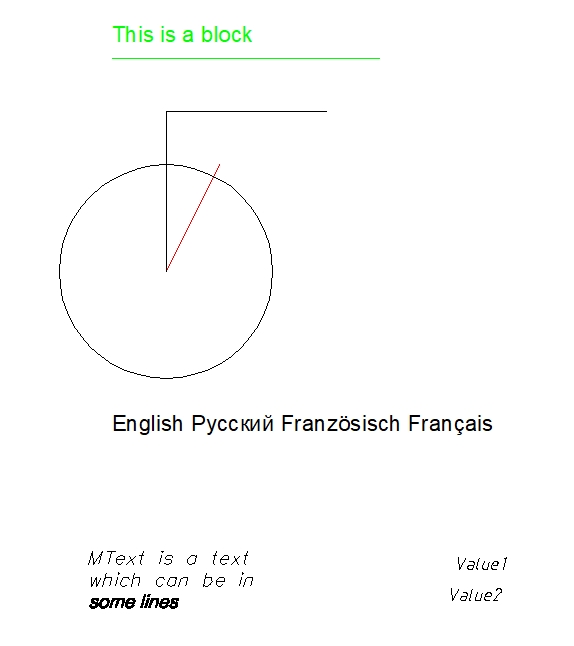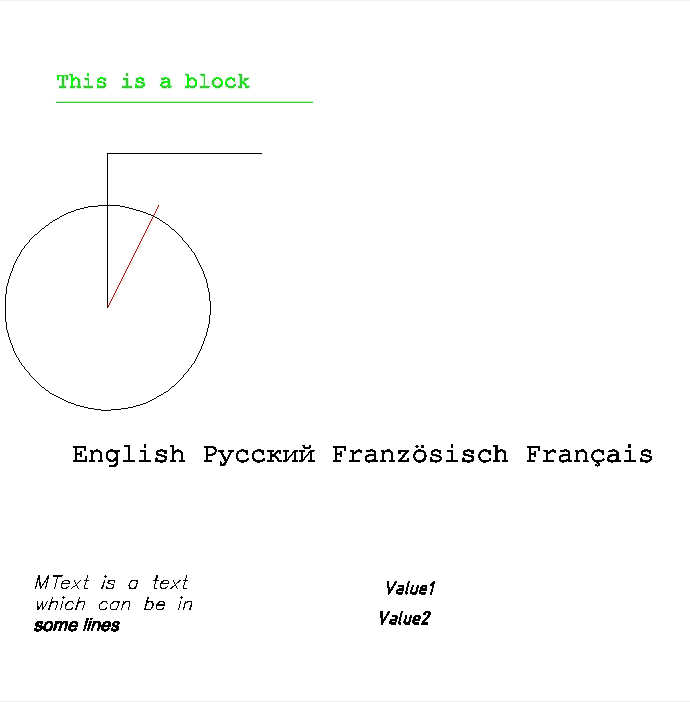How to change a font style of existing text entities?
It is possible to change a font style of existing text entities with the CADStyle class.
In this example we will use the Entities.dxf file. You can find it in ...\CAD .NET 14\Files.
By default, the CAD .NET folder is unpacked to Documents.
The following picture illustrates this file.

Let's create a function to change the font style of existing text entities.
- Add the
usingdirective with theCADImportandCADImport.FaceModulenamespaces.
using CADImport;
using CADImport.FaceModule;
More information about CADPictureBox
The CADPictureBox class is the basic implementation of the control element for displaying vector drawings. Visually CADPictureBox includes only area for drawing visualization and can be extended by the required control elements in the project under development.
To get more information about the CAD .NET controls, see What controls does CAD .NET have?
- Use the control element of the
CADPictureBoxclass:- Set the
Locationproperty asnew Point(10, 30). - Set the
BackColorproperty asColor.Black. - Set the
Sizeproperty asnew Size(995, 500). - Finally, add it to the form.
- Set the
...
CADPictureBox pictureBox1 = new CADPictureBox(){
Location = new Point(10, 30),
BackColor = Color.Black,
Size = new Size(995, 500),
}
public Form1()
{
Controls.Add(pictureBox1);
InitializeComponent();
}
- Add a new button. Name it
ChangeFontOfExistingEnt. Then create theChangeFontOfExistingEnt_Clickfunction to create a new CAD drawing by click.
private void ChangeFontOfExistingEnt_Click(object sender, EventArgs e){
- Create a new instance of the
CADImageclass.
CADImage vDrawing = CADImage.CreateImageByExtension(@"Entities.dxf");
vDrawing.LoadFromFile(@"Entities.dxf");
We recommend creating a new drawing object using CreateImageByExtension in case of importing from an existing file or stream.
- Set the
CurrentLayoutproperty asvDrawing.Layouts[0].
vDrawing.CurrentLayout = vDrawing.Layouts[0];
- The text style named
"STANDARD"is added by default to any drawing created with CAD .NET. Create an instance of theCADStyleclass and define it asvDrawing.Converter.StyleByName("STANDARD").
CADStyle vStyle = vDrawing.Converter.StyleByName("STANDARD");
- Set the
FontNameandPrimaryFontasCourier Newandcour.ttf. LoadvStyleto the specifiedvDrawing.Converterwith theLoadedmethod.
vStyle.FontName = "Courier New";
vStyle.PrimaryFont = "cour.ttf";
vStyle.Loaded(vDrawing.Converter);
- Create a cycle to change the font style of all existing
CADTextentities:- Create a cycle to search for entities on the current layout of
vDrawing. - Find the
CADTextentities with theif/elsestatement. - Find the
CADTextentities which style is"STANDARD".
- Create a cycle to search for entities on the current layout of
for (int i = 0; i < vDrawing.CurrentLayout.Count; i++)
{
if (vDrawing.CurrentLayout.Entities[i].EntType == EntityType.Text)
{
CADText vText = (CADText)vDrawing.CurrentLayout.Entities[i];
if (vText.Style.Name == vStyle.Name)
{
vDrawing.Converter.Loads(vText);
}
}
}
vDrawing.GetExtents();
- Declare the local variable
vRectand specifyRectangleFas its type. This variable stores four floating values that represent the location and size of a CAD file. Use the following code to fit the CAD file topictureBox1. Finally, render the drawing with theDrawmethod.
RectangleF vRect;
double vRatio = (double)(vDrawing.AbsHeight * pictureBox1.ClientSize.Width) / (vDrawing.AbsWidth * pictureBox1.ClientSize.Height);
if (vRatio > 1)
vRect = new RectangleF(0, 0, (float)(pictureBox1.ClientSize.Width / vRatio), (float)pictureBox1.ClientSize.Height);
else
vRect = new RectangleF(0, 0, (float)pictureBox1.ClientSize.Width, (float)(pictureBox1.ClientSize.Height * vRatio));
vDrawing.Draw(pictureBox1.CreateGraphics(), vRect);
}
You have created the function to change the font style of existing text entities.
The following picture illustrates the result.

The full code listing.
...
using CADImport;
using CADImport.FaceModule;
namespace WindowsFormsApp1
{
public partial class Form1 : Form
{
CADPictureBox pictureBox1 = new CADPictureBox()
{
Location = new Point(10, 30),
TabIndex = 10,
BackColor = Color.Black,
Size = new Size(995, 500)
};
public Form1()
{
Controls.Add(pictureBox1);
InitializeComponent();
}
private void ChangeFontOfExistingEnt_Click(object sender, EventArgs e)
{
CADImage vDrawing = CADImage.CreateImageByExtension(@"Entities.dxf");
vDrawing.LoadFromFile(@"Entities.dxf");
vDrawing.CurrentLayout = vDrawing.Layouts[0];
CADStyle vStyle = vDrawing.Converter.StyleByName("STANDARD");
vStyle.FontName = "Courier New";
vStyle.PrimaryFont = "cour.ttf";
vStyle.Loaded(vDrawing.Converter);
for (int i = 0; i < vDrawing.CurrentLayout.Count; i++)
{
if (vDrawing.CurrentLayout.Entities[i].EntType == EntityType.Text)
{
CADText vText = (CADText)vDrawing.CurrentLayout.Entities[i];
if (vText.Style.Name == vStyle.Name)
{
vDrawing.Converter.Loads(vText);
}
}
}
vDrawing.GetExtents();
RectangleF vRect;
double vRatio = (double)(vDrawing.AbsHeight * pictureBox1.ClientSize.Width) / (vDrawing.AbsWidth * pictureBox1.ClientSize.Height);
if (vRatio > 1)
vRect = new RectangleF(0, 0, (float)(pictureBox1.ClientSize.Width / vRatio), (float)pictureBox1.ClientSize.Height);
else
vRect = new RectangleF(0, 0, (float)pictureBox1.ClientSize.Width, (float)(pictureBox1.ClientSize.Height * vRatio));
vDrawing.Draw(pictureBox1.CreateGraphics(), vRect);
}
}
}